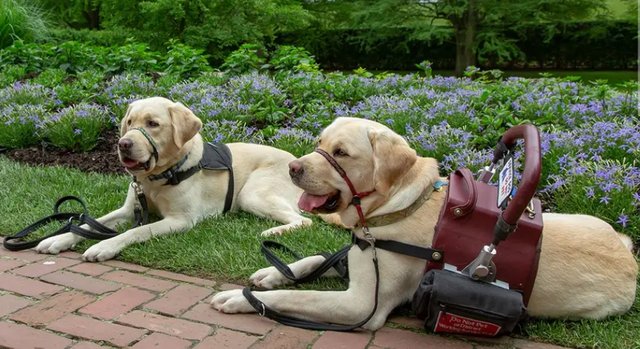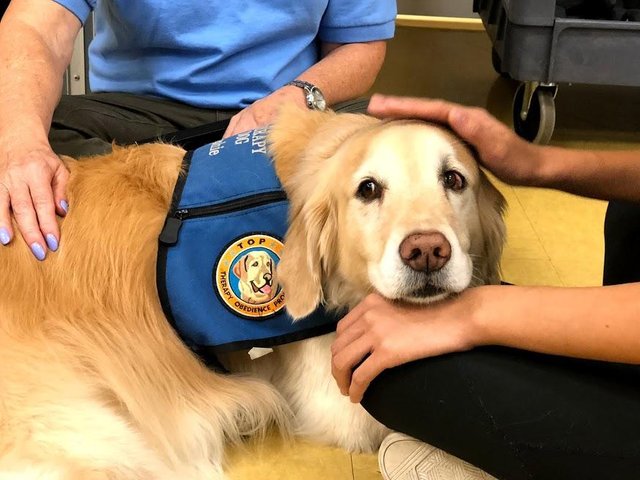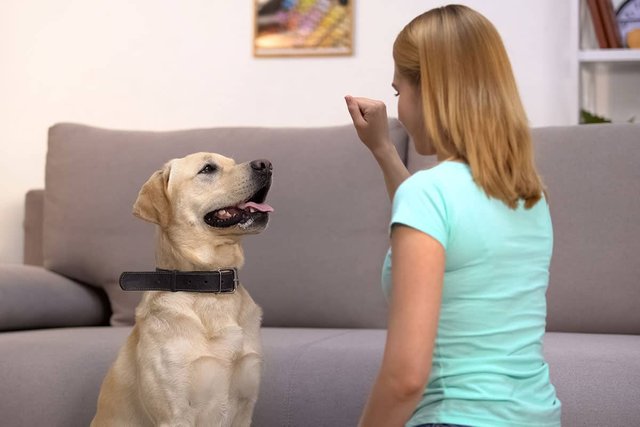Generally speaking, both therapy dogs and companion dogs are your best friend and also your constant buddy. They obtain this classification from being able to assist the owner with a multitude of problems. Therapy Dogs and Companion Dogs can also be classified as having almost the same abilities as Service Animals but basically are NOT animal assistance dogs that help individuals with physical disabilities.

But what exactly is the difference between Companion Dogs and Therapy Dogs?
Okay, let me start by defining what a therapy dog is. Usually, they are found in retirement homes, nursing homes, hospitals, and schools. They aide people with difficulties in learning, and help to calm stressful situations that can be normally seen in disaster areas caused by natural hazards, such as tornadoes, hurricanes, tsunamis, floods, earthquakes, technological hazards including nuclear and radiation accidents, or sociological hazards like riots, terrorism or war.
In short, Therapy Dogs are specifically trained to provide affection and comfort to people who need it as I mentioned a while ago. They are well known for their temperament. They are patient, friendly, confident, gentle, and easy in whatever situations... Your dog needs to have these characteristics to be classified as qualified Therapy Dogs. Why is that so? This is because they are expected to enjoy human contact, and can be petted and handled by people carefully and even clumsily. They come in all breeds and sizes.
It is a Therapy Dog's job to have other people even the unfamiliar ones have contact with them and these people should enjoy that connection. But, why? Okay, as we all know, children always love hugging animals, while adults love petting them. In some situations, the Therapy Dogs might need to be lifted onto, climb onto, placed onto an individual's lap, sleep on an adult's or kid's bed, and either sit or lie comfortably there.
Therapy dogs need to be comfortable in these situations and must cope depending on a person's need to be able to provide emotional support to both adults and children. They are expected to be stroked, held, and sometimes just watched.
People oftentimes got confused between therapy dogs vs. service dogs. I wanted to clear it up. Therapy Dogs are not service or assistance dogs. Service dogs directly assist humans, it is legal for these dogs to accompany their owners in almost all areas, and in fact, in the United States alone, Service Dogs are protected under the Americans with Disabilities Act of 1990 which is a wide-ranging civil rights law that prohibits, under certain circumstances, discrimination based on disability.
Therapy Dogs on the other hand are not mentioned in this law simply because they did not provide direct assistance for people with disabilities so this is why some institutions give limit and prohibit access for Therapy Dogs but, in most cases, they allowed it, however, institutions may impose requirements for Therapy Dog.
There are organizations that provide testing and some accreditations for Therapy animals to assure the institutions that they were tested in an accredited manner.

The establishment accredits dogs who are found to be positive on people, possess good manners in public locations, are in good health with up-to-date shots, and should be always obedient to the owner's command. Most important is that they should not be aggressive.
Related: 10 Reasons Why Your Dog Ignores Your Commands
How are Dogs certified? There are actually a lot of institutions that provide accredited dog certification locally, internationally and even online for owners' convenience.
During the training, Therapy Dogs are tested by Therapy certified groups. It is performed by accredited evaluators who have expert experience in pet therapy and normally evaluates animals in a series of 14 - 22 tests. This will determine the animal's attitude in public like how they act towards medical equipment like people with canes and wheelchairs, walking through the crowd, greeting a stranger, etc. The behavior of the dog during the testing is also evaluated in this case.
A key element of testing is to weed out dogs that are fearful or aggressive, both of which can mean a biting dog. Presently, In the United States, some organizations require that a dog pass the equivalent of the American Kennel Club's Canine Good Citizen test and then add further requirements specific to the environments in which the animal will be working.
Picking the best therapy dog is somewhat difficult. I'm often asked that question... However, my recommendation will be for you to get an adult dog if ever you need one. Why? Because I find it really impossible to tell if a puppy will grow up to be a Therapy Dog at all.
I'm writing this based on experience. I had a puppy who I predicted to grow up as a therapy animal but grew up to only like me alone and nobody else which is not a good trait for a therapy dog. So, my advice is to really look for a grown-up dog or an older puppy. Where to get Therapy Dogs is one more thing to consider. Shelters and most rescue groups are great places to look for Therapy Dogs but you have to be really careful, it is important for the owner to take their time selecting the dog that fits them.
I suggest that you talked to staff people and volunteers about the criteria that you really want, your hopes, and your dreams. Normally the best Therapy Dogs are retired show dogs. Why? Because the fact that they can make a great show proves their people skills and can lead to being future Therapy Animals. Sometimes you just need to take your time and wait for the best dog to find you.
What dogs are eligible to be Therapy Dogs? Actually, pure breed and mixed breeds are all fine as long as they are at least one year old, female or male, neutered or not. So, it's not that difficult to pass this eligibility. As long as they pass the test, they can all be Therapy Dogs. If you have your own dog who you think is eligible, then you can always go ahead and have them evaluated and then have them trained.
So I hope, we're all set with Therapy Dogs. But what about a Companion Dog? It brings a lot of confusion. To make it plain and simple, these are the dogs that do not work. They provide companionship for their owners as well as being a pet. Most common Companion Animals are toy dog breeds which refer to very small dogs like spaniels, pinschers, and terriers.
Why? This is because their looks and traits fit to be used only for the pleasure of their company, but definitely not as workers. Every dog breed was created for a reason and Companion Dogs are not an exception. They can't be discriminated against because on the brighter side, their job is the most important work an animal can do - to keep people company. Any dog can actually be a companion dog.
A Companion Dog is placed with individuals who will actually benefit from the physical and emotional therapy of having a well-trained pet. Companion Dogs help people (especially elders) to live longer, healthier, happier, and more fulfilled life. The most common difference between a Companion Dog and a Therapy Dog is that Therapy Dogs are expected to go out with their owners and be friendly in public.
Companion Dogs on the other hand are simply trained to support their owners in the home environment. So in short, Companion Dogs most of the time are not trained for community access, are not expected to support owners in a public setting, and are not trained to travel on public transport as well.
If Companion Dogs are not working animals, then why do we have to register and certified them? Basically, certification is a legal acknowledgment that your dog can understand and obey basic commands. Certification exists for both service dogs and companion dogs but the qualification of each is not the same most of the time, certified companion dogs are also qualified as certified service dogs in some cases.
This is because some owners trained their pets to make a Skilled Companion dog - these dogs are expected to perform specific tasks at home. Skilled Companion Dogs can actually do many the tasks of that service dogs can do. Besides, not all dogs are cut out to really be a service dogs, as a matter of fact, only a few can make it to be on a level of a service dog.
Not all dogs are comfortable in situations in public and this characteristic should be the most important characteristic a service dog should have - being comfortable on all occasions, and in all situations, they may encounter. However, these dogs can also perform their task well and this can make them skilled companion dogs instead.
Training Companion Dogs is not as difficult as training working dogs, in fact, training only consists of 5 basic commands - sit, come, stay, heel, and lie down. Training is normally done one on one with the dog along with their owners while some still preferred the "class" format.

While all dogs have the ability to learn these basic commands, it's still easier to train puppies. At the end of the training, both the owner and the pet should understand these basic commands.
Suggested article: This nifty little FREE e-book contains a simple game you can play with your dog right away, as well as a special “smacking sound” you can use to get your dog’s attention when needed.
But why do we need to train Companion Dogs? By nature, our dogs are pack animals with well-defined social orders. A dog in your house will always look to you and even to the entire family for guidance. We are their leaders. That leadership can be established in a friendly and well-defined manner.
Owners are leaders who at the same time are expected to be teaching dogs appropriate behavior. Like people, Companion Dogs differ from one another, some are shy, some are serious, some are laid back, while others are hyperactive and this makes training beneficial for the entire family.
To make it specific, training Companion Dogs corrects behaviors such as jumping on people, digging, inappropriate barking, and chewing and at the same time enhancing the dog's mental and physical activities. It deepens the bond between the dog and the owner, providing a higher level of satisfaction and enjoyment that we get from the dog's companionship. Training also ensures dogs' safety and happiness which is beneficial for your family, neighborhood, and even the entire community.
When do you actually need to train your Companion Dog or enroll them in a class? The answer is Now. Nowadays, veterinarians encourage owners to have the puppy trained even before the completion of shots. It could begin as early as seven to eight weeks old. Why? The truth is the number one cause of death for dogs under 3 years of age is not actually infectious diseases - it is the behavioral issues between puppies as they grow up to be dogs.
This only proves that delaying the training until the puppy finishes the vaccines may somehow be damaging beliefs which could affect the dogs in the future simply because they are missing almost 16 weeks when the puppy was isolated from the world.
For those who are not aware of training Companion Dogs, obedience training is the most important and the most effective training the owner and trainer can give to a puppy or dog. Training can make your Companion Dog more than just a pet. In reality Companion, Dogs will always be a valuable members of the family.
The dog will never fail to provide pleasure, protection, and a bond of companionship which is essential in promoting a respectful relationship between your family and your dog.
However, this respect cannot be easily exerted by improper handling methods or mistreatment but is mostly earned through leadership and proper training. You can find more specific info on this at The ‘treasure hunt game’ gets your dog back to his evolutionary roots and relieves the ‘boredom’ that leads to so many problem behaviors.
There is no single answer as to why people choose to have either a pet or a companion dog. To some, having just a pet is the right answer. For others, the Companion Dog is the better choice. Just keep in mind that Companion Dogs undergo a lot of training including extensive obedience training making them capable of handling many situations and more exposed to environments that many dogs will never see. They are even trained to call 911 in emergency cases and these benefits maybe most of us will want. However, in the end, it is still your choice.
Nice article with great detail. I have had obedience trained dogs and find, in general, that dogs who are well trained bond so well with their human counterparts and this provides for confidence and joy in their lives. The human-animal bond is so amazing and I'm glad we're recognizing some of the legitimate value that having animals in our lives, whether Therapy or Companion, has provided for so many.
Downvoting a post can decrease pending rewards and make it less visible. Common reasons:
Submit